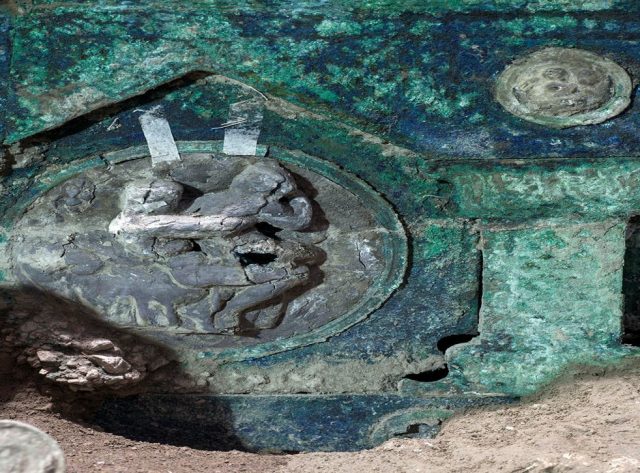independent.ie– Archaeologists have described as “exceptional” the discovery of an ancient Roman chariot, decorated with male and female erotic figures, near the town of Pompeii.
The large, four-wheeled ceremonial chariot was found in the remains of a villa to the north of the ancient Roman town, which was buried in ash after the eruption of Mount Vesuvius in AD79.
Decorated with cupids, nymphs and satyrs, it could have been used in parades or as a way of conveying a wealthy bride to her wedding, experts believe.
The chariot, known in Latin as a piletum, would have been used by the Roman elite for ceremonies and would have carried one or two people.
Archeologists unearthed the iron components of the chariot as well as “beautiful bronze and tin decorations and mineralised wood remains,” they said.
“This is an exceptional discovery, not only because it adds an additional element to the history of this dwelling and the story of the last moments in the lives of those who lived in it, but above all because it represents a unique find – which has no parallel in Italy thus far – in an excellent state of preservation,” the statement added. The chariot was found in a portico facing a stable where the remains of three horses, one still in its bronze harness, were found in 2018.
Archeologists have been excavating the area, known as Civita Giuliana, to deter the looting of ancient remains by gravediggers, who sink tunnels and steal whatever valuables they can find.
The chariot was lucky to have escaped the attention of looters. It had “miraculously been spared by both the collapse of the walls and ceiling of the room and by the illegal activities, with tunnels passing it by on two sides”.
The fragility of the chariot made it a particularly delicate excavation, the experts said.
The remains of the chariot were transferred to the laboratory of the Archaeological Park of Pompeii, where they will undergo further restoration and put on display.
Without the intervention of archeologists, public prosecutors and a specialised unit of the Carabinieri police, the chariot could have been looted and sold on the black market, they said.
Massimo Osanna, the outgoing director of Pompeii, said chariots had been found in the area before, but “nothing like” this latest discovery.







